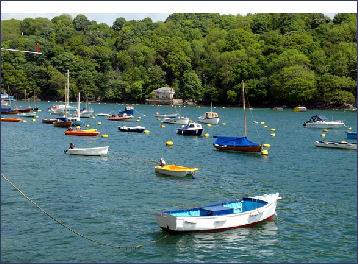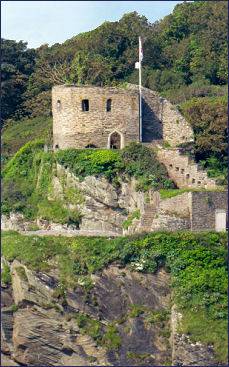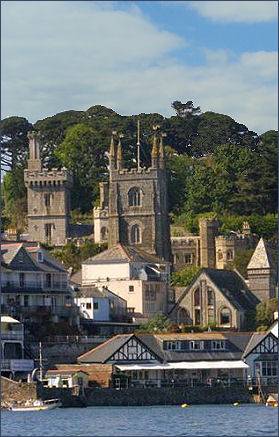Fowey
OS Grid ref:- SX126516
 The town of Fowey, pronounced 'Foy', and known in Cornish as Fowydh, lies on the Cornish Riviera between Looe and Mevagissey and occupies a hillside above the Fowey estuary.
The town of Fowey, pronounced 'Foy', and known in Cornish as Fowydh, lies on the Cornish Riviera between Looe and Mevagissey and occupies a hillside above the Fowey estuary.
The Elizabethan sea-dogs, Drake, Frobisher and Sir Walter Raleigh once sailed from Fowey's characterful old harbour.The Fowey estuary is designated an area of Outstanding Natural Beauty, much of the surrounding woodland and countryside is under the ownership of the National Trust.
 During the Civil War Fowey held Royalist sympathies, in 1644 the Earl of Essex marched a Parliamentarian army to Lostwithiel and occupied the peninsula surrounding Fowey. In August, a Royalist army surrounded Essexís troops. King Charles I viewed Fowey from Hall Walk above Polruan, where he came close to being hit by a musket shot. On 31 August, the Parliamentarian cavalry forced their way through the Royalist lines and retreated towards Saltash, leaving the foot soldiers to be evacuated by sea from Fowey. Essex and some officers did indeed escape, but the majority of the force surrendered a few days later near Golant and were then marched to Poole.
During the Civil War Fowey held Royalist sympathies, in 1644 the Earl of Essex marched a Parliamentarian army to Lostwithiel and occupied the peninsula surrounding Fowey. In August, a Royalist army surrounded Essexís troops. King Charles I viewed Fowey from Hall Walk above Polruan, where he came close to being hit by a musket shot. On 31 August, the Parliamentarian cavalry forced their way through the Royalist lines and retreated towards Saltash, leaving the foot soldiers to be evacuated by sea from Fowey. Essex and some officers did indeed escape, but the majority of the force surrendered a few days later near Golant and were then marched to Poole.
The town has a superb sandy beach at Readymoney Cove, Known in Cornish as Porth Mundy, meaning mineral house cove, Readymoney Cove is situated close to the mouth of the River Fowey Estuary, there is ample parking and lifeguards in season. Dogs are allowed only from Easter- October.
St. Catherine's Castle, (right) which is in walking distance of the cove, is a small artillery fort which was constructed in 1536 by 'England's Bluebeard', King Henry VIII to defend Fowey harbour agaist French invasion. The castle has two storeys with gun ports at ground level. The remains of the castle overlook the estuary and can be accessed via a short path from the beach. The castle is now owned by English Heritage, entrance is free.
 Fowey offers a wide range of accomodation to suit all budgets, restaurants, cafes, shops and
art galleries. The Fowey Museum, a small but interesting museum situated in the oldest part of the town, is housed in the town hall and hosts displays on Fowey's maritime history.
Fowey offers a wide range of accomodation to suit all budgets, restaurants, cafes, shops and
art galleries. The Fowey Museum, a small but interesting museum situated in the oldest part of the town, is housed in the town hall and hosts displays on Fowey's maritime history.
Place House, a thirteenth century manor house in the town has for centuries been in the possession of the Treffry family. During the medieval period the Treffrys became very wealthy merchants exporting tin, fish and wool. John Treffry was granted a knighthood by King Henry VII. Place House was defended against the French in 1475 by his wife Dame Elizabeth Treffry, the defenders are said to have poured boiling lead, stripped from the roof, upon the heads of their attackers. The house was extensively remodelled by Joseph Thomas Treffry in the early nineteenth century.Place House is not open to the general public, the best view of the tower is from beside the River Fowey.
At either side of the harbour entrance are the ruins of the thirteenth century blockhouses, built as a defence to bar entry to the harbour via a chain.
The Fowey to Mevagissey Ferry links the two ports between May and September inclusive. This offers a fun, fast sea crossing for passengers only and a chance to enjoy one of the most beautiful parts of Cornwall's coastline from the water at a modest cost.
St. Fimbarrus Church, which dates back to medieval times is dedicated to the sixth century St. Fimbarr, who stayed in Fowey. The church was rebuilt in the 1460s after a raid by the French destroyed the earlier Norman church on the site, it was restored at the end of the nineteenth century. The building has an impressive 500-year-old wagon roof and rood screen, the pulpit was constructed from a Spanish galleonís captainís cabin and the font survives from the earlier Norman church.
Next to the church stands the Daphne du Maurier Literary Centre, containing information on the author, how she came to Cornwall and and her connections to Fowey. There is also a short video that can be watched at any time showing areas of interest and enhanced history. (Open daily 9.30am to 5.00pm).
An interesting Iron Age Fort, Castle Dore, dating from between between the first centuries BC and the fifth Century AD, lies nearby. The earthwork, which measures 225 feet in diameter, has twin defences, each consists of a bank about 8 feet high with a deep outer ditch. Excavations have revealed a stone guard house by the inner entrance. The hall was once believed to have been the fortress of King Mark of Cornwall.
A mile and a half from Castle Dore, stands a stone pillar known as the Tristan Stone on which is carved the Latin inscription 'Drustans Hic lacit/Cunomori Filius' (Here lies Drustan son of Commorus) Commorus has been identified as Mark of Cornwall and Drustan as the Tristan of in Arthurian legend. The stone did not always stand in its present position but lay nearby, the exact position has unfortunately gone unrecorded.
Walks from Fowey
The Saint's Way
An ancient 26 mile (42km) track across Cornwall, known as the Saint's Way, commences at Padstow harbour and continues to Fowey. The track was originally used by Bronze and Iron Age traders. In the centuries which followed, Celtic Christians traversed the path, erecting granite crosses along the route.